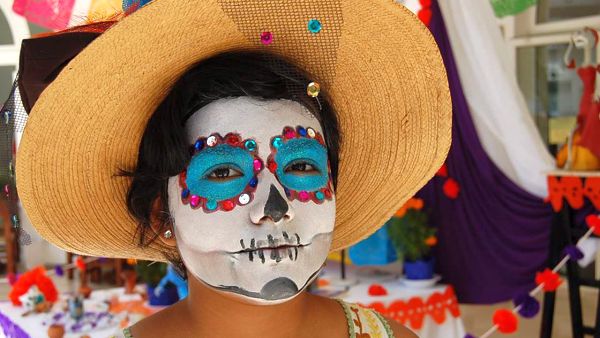Puerto Vallarta, Jalisco, Mexico - There's nothing like seeing how people are memorialized to get a deeper glimpse into that culture. Touring a cemetery in Mexico during Día de Muertos (Day of the Dead) reveals a beautiful tradition of remembering those who have passed amid the celebration of life.
The belief is that the human spirit does not die, and can travel between this world and the afterlife. It's during Día de Muertos when souls of the deceased are allowed to return to their loved ones. Celebrations happen all over Mexico, with festivals and festivities taking place for up to a week long. The actual holiday days are at the start of November, when children are said to reunite with loved ones on the 1st, and adults on the 2nd.
Families get together to remember ancestors, and plan and prepare seven-level altars that tell stories about lives lived and legacies left.
 |
Puerto Vallarta is a vibrant artistic city that pays special homage to the holiday with exhibitions, music, dancing, parades, and all kinds of parties.
Locals and tourists alike get into the spirit by donning colourful costumes and painting their faces with fascinating designs that signify both life and death, sporting macabre features like dark eyes and stitched mouths juxtaposed with swirly flowery decorations.
The heart and soul of public celebrations is in the Centro Historico district, where the Día de Muertos Artwalk adorns the galleries and shops in the square with row upon row of altars and ofrendas (offerings). Here, you'll find tributes to famous people and cultural icons among the shrines of so many who are unknown to the masses, but remembered by the community.
The famous Malecón boardwalk with stunning views of the Bay of Banderas comes even more alive with the dead, with larger-than-life skeleton statues, demonstrations, and the best people-watching around. Cobblestone streets everywhere are lined with streamers and flags floating on overhead wires that gently flap when the breeze blows. Or anytime a spirit passes by.
The cemeteries themselves are even more remarkable, with the smell of incense wafting through the air, endless displays of ofrendas, and countless candles casting an eerie yet comforting glow on the tombs and monuments. It's here that families hold vigils, coming together to spend time sharing stories and memories of those whose graves they visit.
A beautiful tradition indeed that I'm glad I got to experience myself. Because celebrating the dead definitely gave me a little bit better of a perspective on this thing called life.
Originally published by the Winnipeg Free Press, this article was written by RoseAnna Schick, an avid traveller who seeks inspiration wherever she goes.


